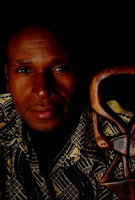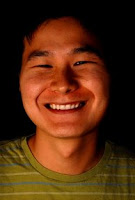
[Outside Union Station in Chicago. All photos by Visperd Mada-Doust.]
-- by Dave
One of the real attractions to joining the Dreams Across America train, for me at least, was that I would get to see so much of the country up close. When nearly all of your travel is done by air, you see America from a distance (if you even bother to look out your window).
But when you do it by land -- train, bus, car, or bike -- you really get to see it. I intend someday to cross the country by bike, though I haven't much desire to do the bus or car thing. But a train? That always sounded very cool to me.
And it has been. But what's turned out to be even more special about this trip is the fact that I've been traveling with a train full of immigrants from all walks of life from all over the nation.
If America is as much its people as its landscape, I've seen America up close and personal both ways on this trip. And it has been an amazing thing.
The group of immigrants and their advocates that has gathered for this tour is incredibly diverse. They range from Native Americans to Caucasian housewives to African-American teachers to Germans and Italians and Poles to Pakistani and Korean mothers to Iraqi soccer players to Salvadoran refugees to, yes, Mexicans.
The one thing they all have in common is an enormous strength of character and an idealistic belief in the American Dream. They are, really, America at its strongest and finest.
 Take, for example, Mike Wilson. He is a member of the Tohono O'Odham Nation, a tribe whose reservation is located in the Sonoran desert on the Arizona-Mexico border. Wilson of course is not an immigrant in the least, but he is a fierce advocate for them, particularly for defending the humanity of the border crossers, who have been dying in ungodly numbers on his tribe's land. As a leader of Humane Borders, he makes it his business to set out water, food, and aid supplies in the desert to help save the lives of the crossers. In person, he's quiet and yet powerful, and you can tell that his convictions are backed up by sobering real-life experience.
Take, for example, Mike Wilson. He is a member of the Tohono O'Odham Nation, a tribe whose reservation is located in the Sonoran desert on the Arizona-Mexico border. Wilson of course is not an immigrant in the least, but he is a fierce advocate for them, particularly for defending the humanity of the border crossers, who have been dying in ungodly numbers on his tribe's land. As a leader of Humane Borders, he makes it his business to set out water, food, and aid supplies in the desert to help save the lives of the crossers. In person, he's quiet and yet powerful, and you can tell that his convictions are backed up by sobering real-life experience.Or there's Cathy Gurney, the Sacramento woman who tells her story in video here. Gurney operates a landscaping business that relies almost entirely on Latino labor; as I've mentioned, Gurney makes a powerful case that her business would not survive without that labor, not merely because it's work that white Americans won't do, but also because of the incredible work ethic that Latinos bring to the table. Gurney is bright and vivacious, a lifelong Republican, and absolutely adamant about the importance of recognizing Latino laborers as the formidable component of the nation's economic engine.
 There's Hee Pok Kim, also known as "Grandma Kim," an elderly Korean woman from Los Angeles (originally from Pyongyang) whose lack of English skills doesn't keep her from communicating a real warmth and intelligence, as well as her fierce determination in helping to change the nation's immigration laws -- not for herself, but for her children and family and others like her, who have to jump through so many hoops to become "legal" immigrants that it's no wonder they eventually give up.
There's Hee Pok Kim, also known as "Grandma Kim," an elderly Korean woman from Los Angeles (originally from Pyongyang) whose lack of English skills doesn't keep her from communicating a real warmth and intelligence, as well as her fierce determination in helping to change the nation's immigration laws -- not for herself, but for her children and family and others like her, who have to jump through so many hoops to become "legal" immigrants that it's no wonder they eventually give up. Or Samina Faheem Sundas, a middle-aged Muslim woman from Pakistan who runs American Muslim Voice. Samina's passion to fix the broken immigration system runs so deep that she gave up her job with a preschool-education foundation in order to make the trip. Or Doris Castaneda, an elderly woman from Guatemala who came along to try to change the laws for the sake of her children and grandchildren. Two of them -- a pair of beautiful little girls named Ashley and Desiree -- accompanied her on the trip to help make that point.
Or Samina Faheem Sundas, a middle-aged Muslim woman from Pakistan who runs American Muslim Voice. Samina's passion to fix the broken immigration system runs so deep that she gave up her job with a preschool-education foundation in order to make the trip. Or Doris Castaneda, an elderly woman from Guatemala who came along to try to change the laws for the sake of her children and grandchildren. Two of them -- a pair of beautiful little girls named Ashley and Desiree -- accompanied her on the trip to help make that point. The list, really, goes on and on: Robert Guajardo, a bearded, very Caucasian-looking fiftyish man of Spanish lineage who emigrated here from Mexico. Jules Boyele, who came here from the Democratic Republic of the Congo. Virginia Franklin, an African-American educator from Los Angeles who came along to help fight for the Dream Act, which aims to eliminate the provisions of federal law that harms the education of immigrant children. Father Giovanni Bizzotto, an Italian priest who spent 10 years in Mexico before relocating to California. Tonio Antonioni, a former soccer player from Iraq who fled Saddam Hussein's tyranny and whose wife remains in limbo in what he calls "the worst country in the world."
The list, really, goes on and on: Robert Guajardo, a bearded, very Caucasian-looking fiftyish man of Spanish lineage who emigrated here from Mexico. Jules Boyele, who came here from the Democratic Republic of the Congo. Virginia Franklin, an African-American educator from Los Angeles who came along to help fight for the Dream Act, which aims to eliminate the provisions of federal law that harms the education of immigrant children. Father Giovanni Bizzotto, an Italian priest who spent 10 years in Mexico before relocating to California. Tonio Antonioni, a former soccer player from Iraq who fled Saddam Hussein's tyranny and whose wife remains in limbo in what he calls "the worst country in the world." And on and on: Brian Bautista, a sergeant in the Marine Reserves who found his path to citizenship through a tour of duty in Iraq. Fermin Vasquez, a onetime undocumented student who fled a political nightmare in El Salvador to try to find peace and a new home in America. Gabriella Thomas, a blonde German woman who emigrated here in 1969.
And on and on: Brian Bautista, a sergeant in the Marine Reserves who found his path to citizenship through a tour of duty in Iraq. Fermin Vasquez, a onetime undocumented student who fled a political nightmare in El Salvador to try to find peace and a new home in America. Gabriella Thomas, a blonde German woman who emigrated here in 1969.  Or Hang D. Youk, a Korean man who arrived in Houston in 1998 to join his family and found himself in limbo after his father, a legal immigrant, was killed in a robbery. Wynona Spears, a formerly undocumented emigrant from Belize whose love of jazz led her to dream of a better life, and whose son served two tours of duty in Iraq.
Or Hang D. Youk, a Korean man who arrived in Houston in 1998 to join his family and found himself in limbo after his father, a legal immigrant, was killed in a robbery. Wynona Spears, a formerly undocumented emigrant from Belize whose love of jazz led her to dream of a better life, and whose son served two tours of duty in Iraq.These people are the true face of America in the 21sty century: some white, some black, some Asian, some Latino, whatever -- you name the location on the planet, and there are Americans from there.
It might be easy to shrug them off, along with their stories, with the simplistic perspective of the nativists: "Well, these are all legal immigrants, and the problem we have is with illegal immigrants." But it is of course not that simple. Many of these now-legal immigrants were themselves "illegal" at one time or another in their journeys toward their dreams.
Moreover, as Nathan Thornburgh recently pointed out in his remarkable cover piece for Time on the amnesty issue, it's not logical to expect there not to be law-breaking when the law is onerous to the point of Kafkaesque absurdity:
- If people are frustrated, as they should be, by the fact that some eligible immigrants have been waiting for citizenship for as many as 28 years, then by all means, fix that problem. Streamline the process for legal immigration. But don't blame that red-tape nightmare on the millions of low-wage illegals already here, who form a very different (and vastly more populous) group.
A century ago, the face of America was decidedly white. But two centuries before that, it was primarily Indian. The world changes and shifts, demographics with it.
What America has always been about is our shared values -- a love of freedom and a respect for others' freedoms, our willingness to work hard, our desire to raise our families in a safe and healthy place, and our wish to pass all that on to our children and their children.
For most of the past century -- since the passage of the Immigration Act of 1924, which codified the racist desire to keep out people who were not white (specifically, Chinese and Japanese) -- our immigration laws have been predicated on the desire to keep people out, because we believed their skin color and nationality mattered more than their values. As the Dreamers and their stories make clear, it is time to find a way to welcome those who are, inside, truly American.
When that happens, we finally will begin living up to our own great ideal: the American dream.
No comments:
Post a Comment